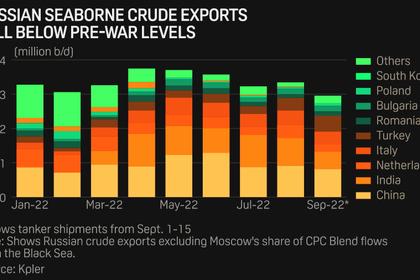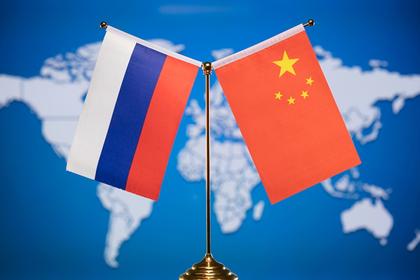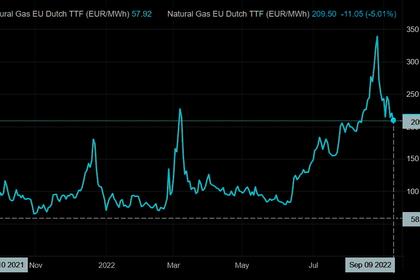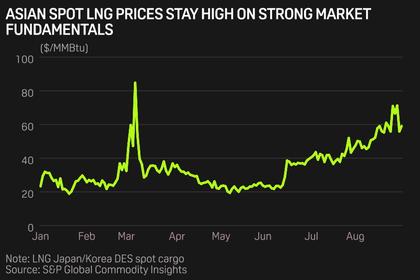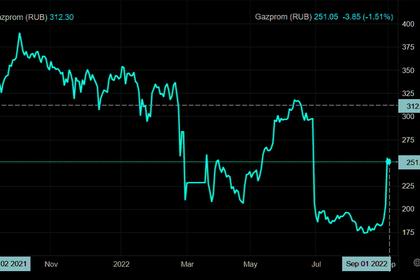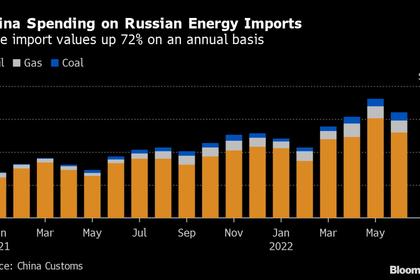
RUSSIAN OIL FOR CHINA UP
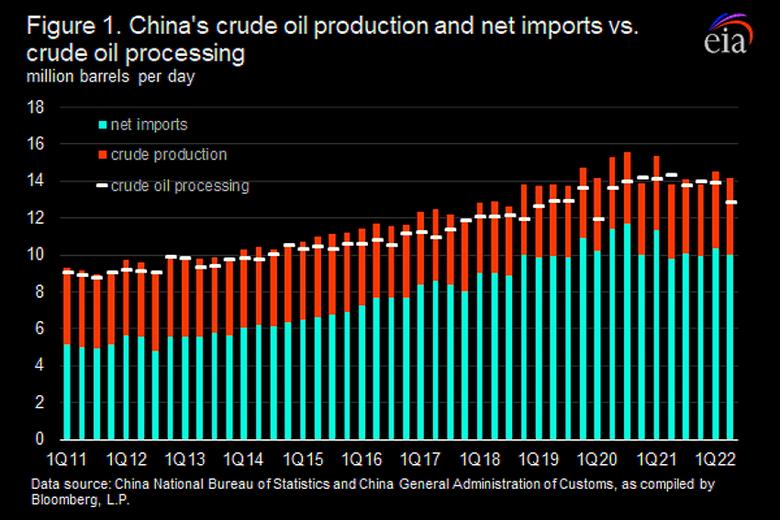
U.S. EIA - September 21, 2022 - The resurgence of COVID-19 cases since March 2022 and China’s policy of localized mobility restrictions have recently reduced refinery activity in China. China’s refineries have been processing less crude oil so far this year than last year, and China has also been importing less crude oil. Despite lower crude oil imports overall, China has increased its crude oil imports from Russia.
In the second quarter of 2022 (2Q22), China processed its least amount of crude oil since 1Q20, the quarter in which responses to the COVID-19 pandemic in China had their strongest effects on economic activity (Figure 1). Although COVID-19 outbreaks since 3Q21 in China have been affecting demand for petroleum products, the 2022 outbreaks and strict mobility restrictions in major cities, including Shanghai beginning in May, have further reduced demand. Despite lower demand for petroleum products, China’s crude oil production has been at record highs this year as a result of national oil companies expanding capital expenditures and production targets to build inventories and prioritize energy security.
Although China’s combined crude oil production and net imports have exceeded crude oil processing, which suggests inventory builds, China has been importing less oil than in late 2020 and early 2021. Some of that decrease may be attributable to crude oil becoming more expensive and making it less economical to stockpile. Low demand for crude oil processing because of reduced domestic demand and lower export quotas for petroleum products, beginning around the second half of 2021, are also likely causes for the decrease. Because of these factors, China’s net imports of crude oil fell to 10.0 million barrels per day (b/d) in 2Q22, according to China’s General Administration of Customs.
China’s crude oil imports were particularly low in June and July. In June, China’s crude oil imports decreased to 8.8 million b/d, the least since July 2018 (Figure 2). Imports remained at 8.8 million b/d in July, down 2.0 million b/d from May of this year, and increased to 9.5 million b/d in August. China exports only small amounts of crude oil (about 20,000 b/d).
Despite China’s total crude oil imports decreasing in recent months, crude oil imports from Russia have increased. Russia is typically China’s second-largest source of crude oil imports, slightly behind Saudi Arabia, and imports from Russia have generally increased over time, both in volume and share of imports (Figure 3). China’s crude oil imports from Russia have increased from 8% of crude oil imports in 2011 (slightly less than 400,000 b/d) to about 16% of crude oil imports in 2021 (1.6 million b/d) and to as much as 21% in August 2022 (2.0 million b/d). The share of total imports from Russia was 20% in June and 19% in July.
The share of imports from Russia has likely risen because of lower imports into China and shifting trade patterns following Russia’s full-scale invasion of Ukraine. Western economic sanctions have reduced demand for Russian crude oil, and as a result, have left Russia to look for alternative export destinations. Meanwhile, Europe has also been looking for alternative sources of crude oil, driving up prices for Brent crude oil. Likely in response to these dynamics, China has shifted its imports away from more expensive Western sources while maintaining high imports from Russia.
From June–August (the three most recent months of data from China’s General Administration of Customs as of September 21), Russia was China’s largest source of crude oil imports, averaging 1.8 million b/d, compared with 1.6 million b/d from Saudi Arabia. Russia is one of just a few countries from which China imported more crude oil in June–August 2022 than in November 2021–January 2022 (the three months preceding Russia’s full-scale invasion of Ukraine). Among China’s largest 15 sources of crude oil imports, China only increased imports from Russia and Malaysia in June–August (Figure 4). Although imports from Malaysia increased by 55%, Malaysia still only made up about 8% of China’s total imports from June 2022–August 2022. Imports from Saudi Arabia, China’s largest crude oil import source, decreased by 9% in the June–August period compared with the three months prior to the invasion, and imports from Iraq, China’s third most common source of crude oil imports, decreased 27% in the same period. In contrast, imports from Russia increased 7%.
During the June–August period, China also imported significantly less crude oil from its top sources in Europe and the United States. Imports from Norway decreased by 82% in this period, and imports from the United Kingdom decreased 100% (from 173,000 b/d to 0 b/d). The relatively high Brent crude oil price associated with Europe’s need to find crude oil imports for the region is likely deterring China from importing crude oil from North Sea producers. This need for other crude oil sources has also diverted crude oil exports from the United States to Europe, rather than to China. China’s imports from the United States decreased by 63% in the June–August period.
In our September Short-Term Energy Outlook (STEO), we forecast China’s petroleum consumption will increase in 2023 to record highs (Figure 5). China completed several projects to expand refining capacity this year, and it has other projects under development that will expand domestic refining capacity next year and support this increased consumption. To meet the expected increased consumption, China will likely continue to import crude oil imports from several sources and increase domestic production. We forecast Russia’s oil production to decrease in 2023 once the EU economic sanctions are in full effect. Our forecasts for both China’s petroleum consumption and Russia’s petroleum production are subject to considerable uncertainty. Factors that could affect our forecast include China’s responses to further COVID-19 outbreaks, changes in global petroleum trade as a result of sanctions against Russia’s crude oil, and other global economic and geopolitical developments.
-----
Earlier:
